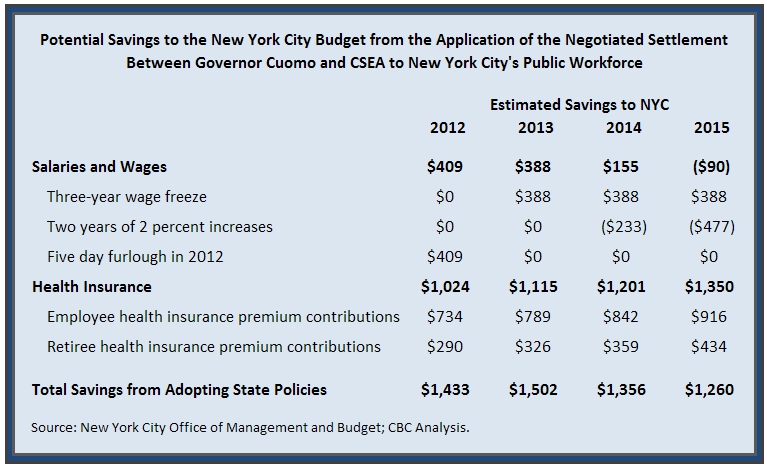State Agreement Is a Template to Avoid City Layoffs
Yesterday, Governor Andrew Cuomo and the Civil Service Employees Association (CSEA) reached a preliminary five-year contractual agreement that provides substantial savings for New York State and, if adopted by other State employee unions, could spare 9,800 employees from the pain of layoffs. In New York City, Mayor Michael Bloomberg, the City Council and municipal unions continue to look for options to prevent 4,300 teacher layoffs, 20 fire company closures and a slew of social service cuts. The State agreement provides a good template for municipal savings on salaries and wages and health insurance.
The State Agreement
The Governor’s agreement with the CESA would produce five-year savings of $3.8 billion if adopted by all State employees. The major provisions of the contract are:
- Base wages will be frozen for the first three years. For the following two years, wages will increase by 2 percent each year.
- Furloughs will be adopted. Employees will take five days of unpaid leave in 2012. They will also take four days of unpaid leave in 2013, but these will be repaid at the end of the contract.
- Health Insurance Premiums: State employees and retirees currently pay 10 percent of their health insurance premium for individual coverage and 25 percent for family coverage. The agreement increases the contributions to 12 percent and 27 percent, respectively, for most employees. Higher paid employees will contribute 16 percent and 31 percent, respectively. Retiree contributions remain unchanged.
Potential for City Savings
Following the template provided by the Governor and the CSEA can produce $1.4 billion in savings for New York City in fiscal year 2012 – more than enough to avert layoffs and other cuts. And the savings continue in subsequent years.
- Base Wages: The Mayor’s budget currently assumes a two-year wage freeze for fiscal years 2011 and 2012; beginning in 2013, the budget assumes salary increases of 1.25 percent. Adopting the State’s plan would extend the wage freeze to a third year for $388 million in savings in 2013; however, the 2 percent salary increases in the State agreement exceed the City’s budgeted amounts and would offset the savings from the extending the wage freeze beginning in 2015.
- Furloughs: A five day furlough for all municipal employees would save $400 million in 2012.
- Health Insurance Premiums: City employees and retirees currently make no contribution toward the cost of their health insurance premiums. If they made the same contributions required by CSEA employees under the new arrangement, the City would save $735 million, and the savings would grow to $915 million by 2015. Similarly, if the City adopted the State’s long-standing policy for retiree premium-sharing (10 percent for individuals and 25 percent for families), the City would save an additional $290 million in fiscal year 2012.
The City’s leaders and the Municipal Labor Committee should consider these changes seriously. While one-shots such as drawdowns from the Retiree Health Benefits Trust Fund or the Health Insurance Stabilization Fund seem like easy answers, these fiscal gimmicks provide only temporary relief from budget pressures; the City will find itself in the same predicament again next year unless it follows the example set by State labor and management.
